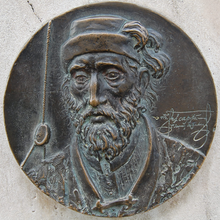Pedro Sarmiento de Gamboa
Pedro Sarmiento de Gamboa (* around 1532 in Alcalá de Henares ; † 1592 ) was a Spanish navigator , cosmographer , historian and governor of the Strait of Magellan .
Life
According to his own admission, he was the son of Bartolomé Sarmiento from Pontevedra in Galicia and María Gamboa from Bilbao in the Basque Country and was born around 1532 in Alcalá de Henares near Madrid. He spent his childhood in his father's house on the Galician Atlantic coast until he was 18 years old. From 1550 to 1555 he was a soldier and took part in wars in Europe. Then he went to America. Via Mexico and Guatemala he came to Peru in 1555, where he devoted himself to seafaring.
In 1568 he was involved in the discovery of the Solomon Islands by Alvaro de Mendaña de Neyra .
From 1570–1572 he traveled to Peru, collected ancient evidence of the Inca and their descendants and wrote a geographical description of the country as well as a history of the Inca ( Historia Índica ) and the Spanish conquest.
In 1579 Gamboa was entrusted by the Viceroy of Peru , Francisco de Toledo , with the defense of all Spanish ships and settlements on the Pacific coast. During this time, Francis Drake was making his forays along the Peruvian and Mexican coasts and it was believed that he would return through the Strait of Magellan . Gamboa should stop him. With eleven ships that had started from Callao in 1579 , he waited in vain in the Strait of Magellan for Drake, who had traveled back via the Cape of Good Hope , and returned to Spain in 1580.
On Gamboa's report, Philip II of Spain decided to have the Strait of Magellan fortified, appointed him governor and captain general of the lands on the Strait of Magellan and sent 24 ships with 2,500 men on board under Gamboa and Diego Flores Valdez , a voyage that was for Gamboa did not go well: the fleet lost eight ships in the storm, and Valdez left Gamboa in a dispute and traveled back to Spain with twelve ships.
Gamboa reached the Strait of Magellan with the four remaining ships in 1583, where he built Fort Felipe , later called Puerto del Hambre, in a strategically favorable location . He left a garrison of 300 people behind when he made his way back to Europe in 1584. On the way he was captured by an English fleet and held in England until 1588. His colony of Fort Felipe had meanwhile been dissolved and its inhabitants either died of starvation or scattered to the wind.
After his release, Gamboa turned to King Philip to bring his allegations against Diego Flores Valdez, but apparently without much effect, as Gamboa died in poverty in 1592.
The Monte Sarmiento in Tierra del Fuego and the Lago Sarmiento de Gamboa and the Sarmiento Canal in Chile were named in his honor . Martin Selber wrote his life story in his novel Verflucht, Sarmiento! (1976) processed literarily.
literature
- Manuel Lucena Giraldo: Pedro Sarmiento de Gamboa. Fuentes y bibliografía. In: Estudios de historia social y económica de América. 1986, No. 2, pp. 59-88, hdl: / 10017/5724 .
- José Miguel Barros: Pedro Sarmiento de Gamboa. Avatares de un caballero de Galicia. 2nd Edition. Editorial Universitaria, 2005 ( books.google.de ).
- Amancio Landin Carrasco, Life and travels of Pedro Sarmiento de Gamboa. Historical Institute of the Navy, Madrid 1946.
Web links
- Literature by and about Pedro Sarmiento de Gamboa in the catalog of the German National Library
Individual evidence
- ^ Cesáreo Fernández Duro (1830–1908): Pedro Sarmiento de Gamboa, El Navegante . In: Boletín de la Real Academia de la Historia . tape XXVIII , no. IV , April 1896, p. 273–287 ( cervantesvirtual.com [PDF; 1000 kB ; accessed on December 6, 2015]).
| personal data | |
|---|---|
| SURNAME | Sarmiento de Gamboa, Pedro |
| BRIEF DESCRIPTION | Spanish navigator and cosmographer |
| DATE OF BIRTH | around 1532 |
| PLACE OF BIRTH | Alcalá de Henares |
| DATE OF DEATH | 1592 |

